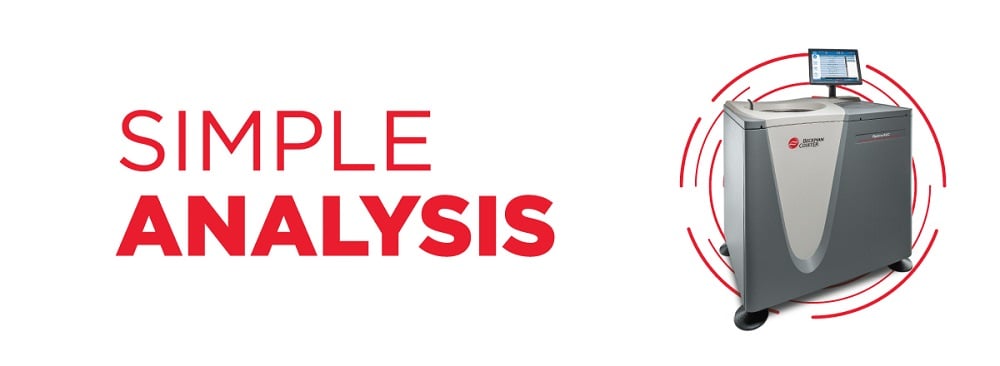
Get AUC Quality Results with Minimal Expertise Using DGE-AUC
Based on the gold-standard preparative density gradient ultracentrifugation (DGUC), density gradient equilibrium analytical ultracentrifugation (DGE-AUC) makes method optimization and analysis easy and relatable. DGE-AUC is a direct measurement method, not relying on complex computations – if you see a peak, it’s real and you can quantify it.
No AUC expert required
Sedimentation Velocity (SV) AUC requires fitting data to the Lamm equation, so there’s often a steep learning curve and specialized software needed for optimal analysis and interpretation. With DGE, the output is directly interpretable, and analysis is not dependent on computational manipulation of other parameters.
Comparing SV-AUC and DGE-AUC

- SV-AUC – at time 0, your particles of interest are uniformly distributed. Once the rotor starts to spin, the particles begin to sediment, a solute depleted region forms, and a boundary is established (multiple species leads to multiple boundaries). Tracking the movement and shape of that boundary over time allows for the calculation of the sedimentation coefficient (S-value).
Analysis of this data often requires special software packages and a steeper learning curve than DGE-AUC.
- DGE-AUC – by adding cesium chloride to a defined final density before spinning, a density gradient will form as centrifugal force is applied. A density gradient will form during centrifugation, and the particles of interest will migrate to where their buoyant density is equal to the surrounding media. At equilibrium, the position of the banded particles directly correlates to the buoyant density of the species (e.g., viral vector packaging or fullness).
This makes DGE-AUC analogous to preparative DGUC, and the Optima AUC allows you to directly monitor this process as it happens and after equilibrium is attained. Analysis of DGE-AUC data is simply peak identification and integration with more universal software.
By nature, the gradient will also concentrate the sample and push away impurities, so you’ll end up with a greatly improved sensitivity in DGE-AUC experiments.
Simple analysis
Data from DGE-AUC can be directly imported into almost any data analysis tool or graphing software (e.g., Excel™ or OriginLab™). Both programs can open multiple AUC files with a single import command. Complete analysis including plotting, quantification and figure generation may be completed in as little as a few minutes or automated for even more efficient analysis.
There is no fitting to the Lamm equation or manipulating variables like partial specific volume. Individual peaks in a DGE-AUC plot correspond to species of a given density, interpretation of DGE-AUC data is as simple as chromatography.
DGE-AUC has immense potential for automation with common software due to its simplicity. A few examples of automatable steps include:
- Importing data
- Baseline correction
- Peak detection & integration
- Peak fitting and deconvolution
- Scan averaging (to improve signal to noise ratio)
How to use both SV and DGE-AUC for viral vector analysis
SV- and DGE-AUC are serotype-independent, orthogonal methods (based on particle sedimentation rate and buoyant density, respectively) for viral vector characterization, and both methods capitalize on multi-wavelength analysis.
SV-AUC is well known as the gold-standard for quantitative assessment of AAV particle fullness and provides additional insights on both aggregated and fragmented particles.
DGE-AUC leverages the high-resolution separation achieved by density gradients, offering lower sample requirements, higher throughput and simplified sample analyses.
What hardware or consumables do you need to run DGE experiments?
DGE-AUC adopters don’t need to worry about purchasing additional materials, other than optical grade cesium chloride (CsCl). The Optima AUC, AUC rotors and typical SV consumables work for DGE. However, if maximized throughput is your goal, then you may want to consider buying 6-channel cell assemblies.
Preparing samples for DGE is very similar to SV, with the only difference in setup being spiking in density forming material like CsCl. Click here for videos on assembling and loading two-sector cells.
Because DGE-AUC is a similar physical process to industry standard preparative DGUC, the same fundamental principles apply, making DGE-AUC relatable, intuitive and predictable.
Get started running DGE-AUC Experiments with the Optima AUC
Ready to start spinning up DGE experiments for robust and simple data analysis? We can help!
Get in touch today to find the best solutions for your lab!
*Third-party analysis software, including Excel and Origin, has not been validated by Beckman for use with the Analytical Ultracentrifuge. Beckman does not endorse any third-party analyses software. Beckman warranty and/or performance guarantee that may be applicable or are provided by Beckman for Analytical Ultracentrifuge do not apply to any third-party software.


